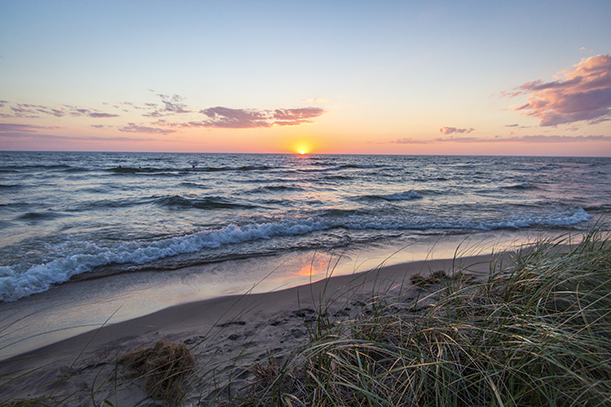BOOMbox at Home: Great Lakes Activities
July 15, 2020

Learn about the nature, environment, and species of Lake Michigan and get inspired to protect and conserve our local resources.
Lake Ecosystems
When you look out over Lake Michigan, the large body of the water may remind you a lot of the ocean, at least during the summer. During the winter, when the lake is at risk of freezing, the differences certainly stand out. Try out an experiment from education.com to learn about freezing point depression, the reason that the ocean doesn’t freeze. A project from The Science Kiddo also shows the differences between density of saltwater and freshwater. Both of these projects use only materials that you probably already have in your kitchen.
Despite their differences, lakes and oceans do have some similar roles in the environment. Both play an integral role in the water cycle. If you’ve ever wondered where rain comes from or how clouds are formed, Mobile Ed Productions has a tutorial for you. With just a plastic bag, water, and tape (plus maybe markers and food coloring for style), you can create a mini-model of the water cycle in a bag right on your window.
Lakes also contribute to wetlands, one of the most biologically diverse types of ecosystems. Wetlands, including swamps, marshes, bogs, and more, are areas of lands regularly (permanently or seasonally) flooded by water. By following instructions from Michigan Sea Grant, you can build your own wetland in a pan to simulate functions of wetlands, including preventing flooding and soil erosion and filtering water. You can use common sponges in place of carpet for this project.
Population Dynamics and Invasive Species
Lake Michigan, along with the other Great Lakes, is home to delicate networks of plants, fish, and other freshwater life. Ideally, these populations naturally keep in balance. You can get an idea of what this looks like by building a food web connecting producers, herbivores, and carnivores. Want to add an artistic flair? You can creatively enhance this activity by drawing rather than listing the different species, using yarn instead of arrows to connect different parts of the chain, or even using slips of paper to make a literal paper (food) chain. You can also play a cool card game from Great Lakes Now for a more interactive way to see how predator/prey interactions shape population levels over time. The game works for both on player and groups.
Unfortunately, the normal balance of an ecosystem can be upset by invasive species. These are species not native to a specific environment that, because they don’t have an established niche or role in that environment, can cause serious harm. Without natural predators, invasive species can take over an environment and wipe out other species by rapidly consuming resources.
One example of an invasive species in Lake Michigan is the lamprey, which earned the nickname “Vampire of the Great Lakes.” As cool as that name may sound, these guys are bad news. At one point, they nearly wiped out lake trout. Fortunately, scientists have made some progress in restricting lamprey spread. You can read more about lampreys at the Great Lakes Fishery Commission, and you can learn about one approach to limiting the lamprey population by playing Break the Barriers, a board game from Michigan Sea Grant, where you play the lamprey trying to bypass barriers.
Pollution and Water Filtration
Invasive species aren’t the only threat to our natural resources. Pollution can contaminate our water, making it unsafe for both people and animals. A great starting point for understanding pollution in lakes and rivers is watersheds. Watersheds determine what water flows into our lakes and rivers. You can use a guide from Learning to Give to make a model of a watershed and explore some ways pollutants might enter the lake.
Once you know some of the ways pollution gets into the water, take some time to explore how we can clean polluted water. Instructables has several tutorials on how to make basic water filters at home. This simple DIY filtration option can be done using mostly materials you can collect outside. Careful--you’ll need to cut open bottles that may then have sharp edges. Younger scientists may need an adult to help with some of the steps.
A more advanced option challenges you to search your home for supplies and incorporate electricity by building a circuit for water filtration. Don’t worry, alternatives are given for supplies you may not have. If you make both, take some time to compare and contrast--which do you think was more effective? Can you find or design some other ways that you could build a filter?
Activist of the Week
Mari Copney, also known as Little Miss Flint, is a Black preteen activist from Flint, Michigan. She is best known for raising awareness about the long-term water crisis in Flint, which was caused by mismanagement of the city’s water supply. She is a youth ambassador for the Women’s March, the Climate March, and Equality for Her. She has spoken in front of the White House, at the Science March in Washington DC, and at the United Nations Girl Up Leadership Conference. She has continued to support her community by raising money and distributing water, books, school supplies, bikes, and letters of support to kids in Flint. She aspires to one day be president.
Share
We’d love to see the results of your experiments! Tag @skokielibrary when you share photos of what you’ve created on social media.
Written by Eli and Frannie.